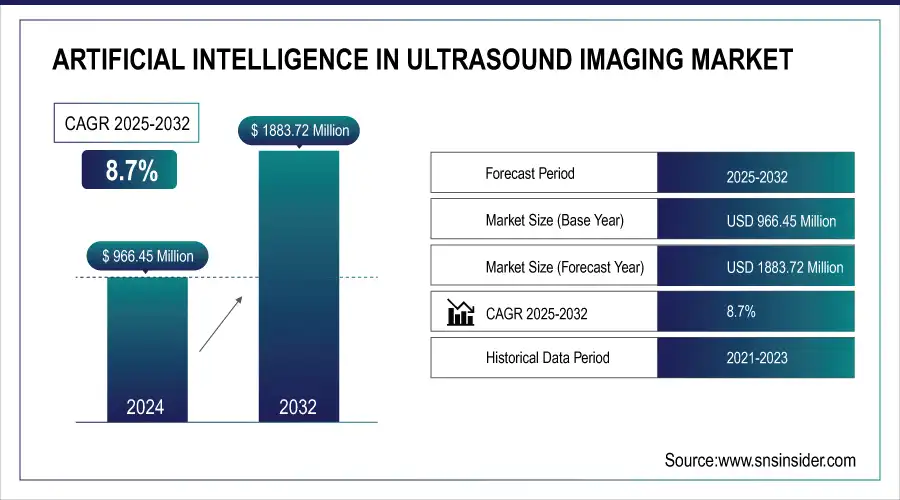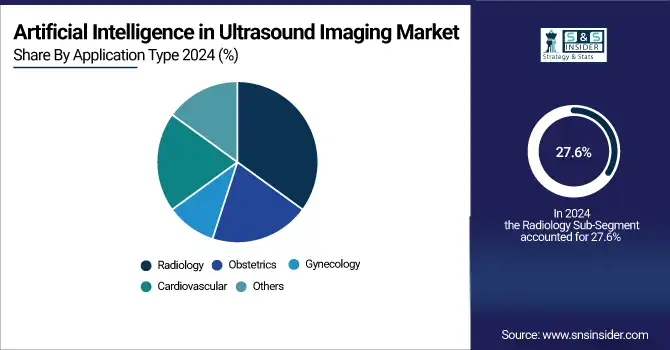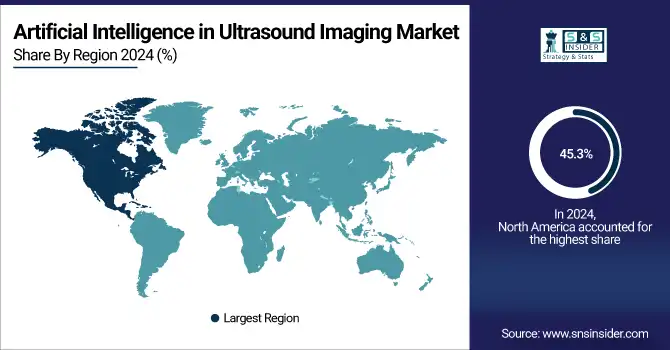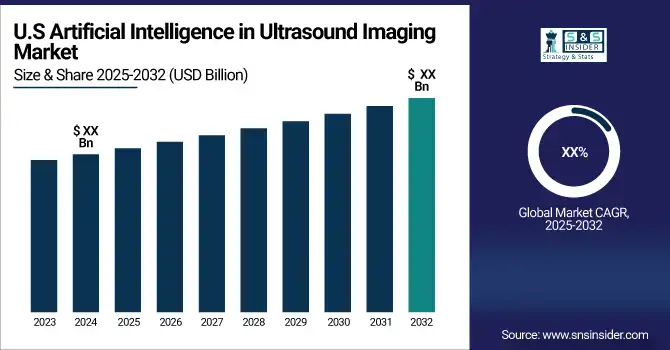Artificial Intelligence in Ultrasound Imaging Market Report Scope and Overview:
The Artificial Intelligence in Ultrasound Imaging Market Size was valued at USD 1050.53 Million in 2025E and is expected to reach USD 2047.60 Million by 2033 and grow at a CAGR of 8.7% over the global forecast period of 2026-2033.
The growing prevalence of lifestyle and chronic diseases within the global population is mainly driving the demand for AI-back ultrasound imaging. This trend is reflected in alarming health statistics. According to International Agency for Research on Cancer, in 2020 nearly 19.3 million new cases of cancer were detected worldwide, and almost 10 million deaths were related to cancer. These numbers are estimated to grow by 47% by 2040, hence the immense need for more precise diagnostic tools. Cardiovascular diseases also amount to around 32% of world deaths based on the review of the World Health Organization (WHO). International Diabetes Federation also projects that the total global diabetic population is going to hike up to 783 million by 2045.

Get More Information on Artificial Intelligence in Ultrasound Imaging Market - Request Sample Report
As incidence levels of chronic diseases continue ascending, so does the urgency for healthcare systems to dispense quick and effective service. More imperative in this regard is the potential of advanced technologies such as AI in ultrasound imaging. It will thus be easier for healthcare providers to perform faster examinations with a greater degree of accuracy, hence quicker diagnosis and higher-quality patient outcomes directly result. This technology is expected to have a big impact in light of mitigating the burden of the hospitals, hence making effective management of increasing numbers of hospital admissions and chronic disease patients. Therefore, this ultrasound imaging AI take-up shall increase multifold in the coming years ahead.
Artificial Intelligence in Ultrasound Imaging Market Size and Forecast:
-
Market Size (2025E): USD 1050.53 million
-
Market Size (2033): USD 2047.60 million
-
CAGR (2026–2033): 8.7%
-
Base Year: 2025E
-
Forecast Period: 2026–2033
-
Historical Data: 2022–2024
Artificial Intelligence in Ultrasound Imaging Market Highlights:
-
Growing adoption of AI in ultrasound imaging is driven by its ability to enhance diagnostic accuracy, speed, and cost efficiency for healthcare providers.
-
AI-powered imaging tools improve workflow efficiency, reduce human error, and support faster clinical decision-making, meeting rising patient-care demands.
-
Increasing pressure on hospitals and clinics to handle higher patient volumes and improve outcomes is accelerating AI integration in diagnostic processes.
-
High implementation and maintenance costs remain key barriers, especially for healthcare facilities in emerging markets.
-
Lack of technical expertise and shortage of trained professionals capable of operating AI-driven systems hinder widespread adoption.
-
Despite challenges, demand is rising as healthcare systems seek improved efficiency, better diagnoses, and scalable solutions, driving long-term market growth.
Major AI Technologies And Their Features
| Technology | Company | Key Features |
|
Acuson Origin |
Siemens Healthineers |
Features include automated measurements, view recognition, imaging assistance, real-time cardiac view recognition, automated contouring, and quantification of cardiac chambers. |
|
EPIQ CVx and Affiniti CVx |
Philips |
These systems offer automated tools for segmental wall motion scoring and 3D quantification of mitral regurgitation, aimed at enhancing cardiovascular imaging and diagnosis. |
|
Venue Ultrasound Systems |
GE HealthCare |
Incorporates the Caption Guidance feature, providing real-time support to clinicians in capturing optimal cardiac images, especially useful in emergency settings. |
|
Lumify with Reacts |
Philips |
Portable ultrasound system that integrates tele-ultrasound capabilities, allowing remote live sharing of images and video streams during scans. |
|
Clarius Handheld Ultrasound |
Clarius Mobile Health |
Offers high-definition ultrasound imaging with AI for automatic calculations and measurements, suitable for various medical fields including emergency and primary care. |
|
Butterfly iQ |
Butterfly Network |
A handheld, whole-body ultrasound system equipped with AI to assist in image acquisition and interpretation, enhancing its usability across multiple clinical scenarios. |
|
SonoSite SII |
Fujifilm Sonosite |
Focuses on enhancing point-of-care ultrasound with AI-driven image enhancement for clearer imaging, aiding rapid decision-making in clinical and field settings. |
|
GE HealthCare Venue Go |
GE HealthCare |
Features AI-powered tools that support clinicians by streamlining workflows and improving diagnostic accuracy, particularly in point-of-care environments. |
Artificial Intelligence in Ultrasound Imaging Market Drivers:
-
Growing Adoption of AI in Ultrasound Imaging Driven by Enhanced Diagnostic Efficiency and Healthcare Demands
Increased interest from healthcare professionals towards the adoption of AI technology, has played a huge role in the acceptance of AI in ultrasound imaging. This is because of its benefits in diagnostic activities, especially as it is making all the difference in transforming the current practice of medical imaging. AI has been integrated into diagnosis to enable healthcare professionals to diagnose at higher accuracy at faster speeds and lower costs. This is because it not only improves the effectiveness of the diagnostic processes but also ensures that more timely findings are brought closer to the patients with increased accuracy.
In addition, this increased pressure on healthcare providers to render fast and efficient patient care while being profitable also further powers the growth of AI in ultrasound imaging. As a result of this enormous demand on hospitals and clinics to make their operations smoother and improve patient outcomes, it has become integral to the diagnosis work of a clinic to be powered with AI diagnostic tools. By optimizing the imaging processes, AI enables health units to respond quickly to the needs of patients and minimizes opportunities for human error.
With healthcare systems being under constant pressure to increase both volumes of patients as well as financial pressure, interest in AI-based ultrasound image-acquiring systems is likely to rise over time. As healthcare providers look to improve diagnoses and operational efficiency, this trend is likely to fuel significant growth in the AI-in ultrasound imaging market over the next few years.
Artificial Intelligence in Ultrasound Imaging Market Restraints:
-
High Costs and Limited Technical Expertise Hindering AI Adoption in Ultrasound Imaging
High costs and limited technical expertise are significant barriers to the adoption of AI in ultrasound imaging. Developing, deploying, and maintaining AI-enabled ultrasound systems require substantial investment in hardware, software, and skilled personnel, which many healthcare facilities, particularly in emerging markets, find challenging. Additionally, the shortage of trained professionals capable of operating AI-based systems and interpreting results limits effective utilization. These factors slow down integration, create disparities in access, and prevent healthcare providers from fully realizing the efficiency, accuracy, and workflow benefits that AI-driven ultrasound imaging can deliver.
Artificial Intelligence in Ultrasound Imaging Market Segment Analysis:
By Technology
The AI in the ultrasound imaging market has been divided into technology-based segments, which include machine learning, computer vision, natural language processing, and other categories. Among the mentioned technologies, machine learning is primarily driving the market with a 36.2% share in 2025 because it can analyze large amounts of image data and boost diagnostic accuracy with time. It is highly crucial in predictive analytics, pattern recognition, and improvement of the precision of image interpretation. The segment has earned appreciation from radiologists and other health personnel as providing data-driven insights that stretch well beyond improving a medical decision.
The fastest-growing segment is computer vision, which enables machines to interpret and process visual information originating from ultrasound images. It hence automates the image analysis in real time. This technology provides great worth in terms of taking care of anomalies with minimal human intervention. Its application reduces diagnostic errors and hastens the workflow. Going forward, it is anticipated that computer vision will register tremendous adoption due to enhanced demands for imaging solutions.
By Application
In terms of application, AI in ultrasound imaging applies to radiology, obstetrics, gynecology, cardiovascular diagnostics, and other areas. Radiology has the top market share 27.6% in 2025 because it deals with massive diagnostic procedures at the center, including cancer detection, musculoskeletal imaging, organ analysis, and many others. AI-ultrasound imaging, backed by deep learning algorithms in radiology, ensures greater accuracy coupled with reduced time taken for interpretation, thus enhancing its utility for radiologists.

However, cardiovascular diagnostics is the application segment that is growing the fastest. The increased prevalence of cardiovascular diseases across geographies worldwide fueled the demand for early and accurate diagnosis, thus fueling the adoption of cardiovascular imaging. AI-driven ultrasound systems provide vivid images of the heart and blood vessels thus enhancing capabilities and improving care for the cardiovascular patient.
By End User
The market has the following ultrasound imaging market end-user segmentation: hospitals, patients, healthcare payers, and others. Hospitals led the market in 2025 with a 35.0% share because they are the major providers of state-of-the-art diagnostic imaging services. The addition of AI in hospital imaging departments improves diagnostic intensity, streamlines the workflow, and reduces the costs of operations, making it a sought-after option for healthcare providers. Larger hospitals are embracing AI-based ultrasound devices to manage the expanding patient load and enhance the delivery of service.
Meanwhile, patients will be the most rapidly growing end-users. Growing home-based healthcare and telemedicine have increased the patient-centric AI-driven ultrasound devices. It enables patients to monitor health conditions from anywhere. This could improve access to diagnostic services in rural and underserved areas, paving an inroads for growth in the future.
Artificial Intelligence in Ultrasound Imaging Market Regional Analysis:
Artificial Intelligence in Ultrasound Imaging Market Regional Analysis:
North America region accounted for the largest share of 45.3% of the global AI in ultrasound imaging market in the year 2025. This was because of the presence of leading pharmaceutical and biotechnology companies along with immense investment in advanced medical technology. The prevalence of chronic diseases is significantly higher in the region, coupled with a substantially high expenditure in the healthcare sector. Both these factors result in increased demands for ultrasound imaging among patients. The region has also gained strength from high technology infrastructure for healthcare and an enhanced opportunity to access healthcare. Thus, North America, therefore, has emerged as a leader within the global market because it has experienced expanding investment in research and development as well as increased adoption of advanced medical equipment and software, thereby further fast-tracking the growth rate of the market.

Do You Need any Customization Research on Artificial Intelligence in Ultrasound Imaging Market - Enquire Now
Asia-Pacific Artificial Intelligence in Ultrasound Imaging Market Trends:
Asia Pacific is expected to emerge as the fastest-growing region in the AI ultrasound imaging market during the forecast period. It is a significant producer of cost-effective ultrasound imaging devices in the region because of the factors for low-cost production. The prevalence of various diseases and the rising demand for accurate diagnostics are driving the adoption of AI in ultrasound imaging systems. The lifestyle upgrades, along with complications arising in pregnancy mainly due to delayed marriages, have increased the consumption of ultrasound imaging in obstetrics and gynecology. Government investments in developing smart hospitals in the region would further fuel the growth of AI in the ultrasound imaging market in the Asia Pacific region.
Europe Artificial Intelligence in Ultrasound Imaging Market Trends:
Europe holds a significant share of the AI in ultrasound imaging market, driven by the presence of advanced healthcare infrastructure and strong regulatory frameworks supporting medical innovation. Countries such as Germany, the UK, and France are leading in the adoption of AI-enabled imaging solutions due to high healthcare expenditure and increasing prevalence of chronic diseases. Additionally, substantial investment in research and development, combined with a focus on precision medicine, is accelerating the deployment of AI-powered ultrasound systems across hospitals and diagnostic centers in the region.
Latin America Artificial Intelligence in Ultrasound Imaging Market Trends:
Latin America is witnessing steady growth in AI ultrasound imaging, supported by rising awareness of advanced diagnostic solutions and gradual improvement in healthcare infrastructure. Countries like Brazil and Mexico are investing in modern medical technologies to improve patient outcomes. The growing prevalence of chronic and lifestyle-related diseases, coupled with increasing government initiatives to upgrade diagnostic capabilities, is driving demand for AI-enabled ultrasound systems. While cost constraints and limited technical expertise present challenges, expanding training programs and partnerships with international AI providers are helping to accelerate adoption.
Middle East & Africa Artificial Intelligence in Ultrasound Imaging Market Trends:
The Middle East & Africa (MEA) region is emerging as a promising market for AI in ultrasound imaging due to increasing healthcare spending and government initiatives aimed at modernizing medical facilities. Countries such as the UAE, Saudi Arabia, and South Africa are investing in advanced diagnostic tools to enhance clinical efficiency and patient care. The rising prevalence of chronic diseases, coupled with the growing need for early detection and accurate diagnostics, is fueling the adoption of AI-powered ultrasound systems. Expansion of smart hospitals and partnerships with global technology providers are expected to further drive market growth in the region.
Artificial Intelligence in Ultrasound Imaging Market Key Players:
-
IBM (Watson Health Imaging)
-
Nvidia Corporation (NVIDIA Clara)
-
Intel Corporation (Intel OpenVINO Toolkit)
-
Microsoft (Azure Health AI)
-
Samsung (Samsung Medison)
-
Butterfly Network (Butterfly iQ+)
-
GE Company (Vivid E95 and Voluson E10)
-
Siemens Healthcare (ACUSON Sequoia and ACUSON Juniper)
-
General Vision (NeuroMem AI Solutions)
-
EchoNous, Inc. (EchoNous AI Ultrasound)
-
CloudMedx Inc. (AI Imaging Analytics)
-
Agfa-Gevaert Group (Agfa HealthCare Enterprise Imaging)
-
Imagia Cybernetics Inc. (Evidens AI)
-
Enlitic, Inc. (AI Medical Imaging Software)
-
Micron Technology, Inc. (Memory and Storage for AI Imaging)
-
Philips Healthcare (EPIQ Elite, Affiniti Series with AI features)
-
Caption Health (Caption AI for Ultrasound Guidance)
-
Koios Medical (Koios DS for Breast Ultrasound)
-
MaxQ AI (AI-powered Emergency Ultrasound Solutions)
Artificial Intelligence in Ultrasound Imaging Market Competitive Landscape:
GE HealthCare, established in 1892 as part of General Electric and spun off as an independent company in 2023, is a global leader in medical technology and digital solutions. Headquartered in Chicago, it offers advanced imaging, diagnostics, and AI-powered ultrasound platforms, serving hospitals and clinics worldwide with innovative healthcare solutions.
-
In April 2024, GE HealthCare introduced its latest AI-powered ultrasound system, the Vscan Air series. This portable, wireless device utilizes AI technology for enhanced diagnostic accuracy and speed, designed to provide improved imaging solutions for point-of-care settings. This launch is aimed at expanding the company’s reach into emerging markets and meeting the growing demand for efficient and portable ultrasound systems.
Siemens Healthineers, established in 1847 as part of Siemens AG and operating independently since 2017, is a global leader in medical technology. Headquartered in Erlangen, Germany, the company provides innovative imaging systems, diagnostic solutions, and AI-powered ultrasound platforms, supporting healthcare providers worldwide in enhancing clinical outcomes and patient care.
-
In May 2024, Siemens Healthineers announced the integration of advanced AI capabilities into its ACUSON Sequoia ultrasound system. The AI-enhanced platform focuses on improving cardiovascular and liver imaging, offering real-time insights and reducing variability in diagnostics. The launch aligns with the company’s broader goal to provide personalized diagnostic solutions across diverse medical fields.
| Report Attributes | Details |
|---|---|
| Market Size in 2025E | USD 1050.53 Million |
| Market Size by 2033 | USD 2047.60 Million |
| CAGR | CAGR of 8.7% From 2026 to 2033 |
| Base Year | 2025E |
| Forecast Period | 2026-2033 |
| Historical Data | 2022-2024 |
| Report Scope & Coverage | Market Size, Segments Analysis, Competitive Landscape, Regional Analysis, DROC & SWOT Analysis, Forecast Outlook |
| Key Segments | • By Technology (Machine Learning, Computer vision, Natural Language Processing, Others) • By Application (Radiology, Obstetrics, Gynecology, Cardiovascular, Others) • By End User (Hospitals, Patients, Healthcare Payers, Others) |
| Regional Analysis/Coverage | North America (US, Canada), Europe (Germany, UK, France, Italy, Spain, Russia, Poland, Rest of Europe), Asia Pacific (China, India, Japan, South Korea, Australia, ASEAN Countries, Rest of Asia Pacific), Middle East & Africa (UAE, Saudi Arabia, Qatar, South Africa, Rest of Middle East & Africa), Latin America (Brazil, Argentina, Mexico, Colombia, Rest of Latin America). |
| Company Profiles | IBM, NVIDIA Corporation, Intel Corporation, Microsoft, Samsung Medison, Butterfly Network, GE Healthcare, Siemens Healthineers, Canon Medical Systems, EchoNous Inc., General Vision, Enlitic Inc., Imagia Cybernetics Inc., Agfa-Gevaert Group, CloudMedx Inc., Micron Technology Inc., Philips Healthcare, Caption Health, Koios Medical, MaxQ AI. |


